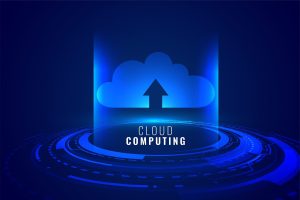 Unveiling Cloud Technologies
Unveiling Cloud Technologies
The modern development of the global economy is accompanied by the widespread use of information systems, with cloud technologies playing a significant role. They have become one of the most important factors influencing the competitiveness of companies in various industries and fields. From corporations to individual users, many turn to the cloud to solve various tasks.
The concept of the cloud was formed in the 1960s, and over the decades, it has changed. Today, the cloud is a complex of technologies for solving various tasks, from developing and launching corporate and user applications to storing and processing vast amounts of data and training artificial intelligence models.
Clouds provide numerous interactive services for users, such as online translators, online games, instant payments, video communication, navigation services, online libraries, music aggregators, text, spreadsheets, photo editing programs, and more.
Large volumes of data are sent to cloud storage, including information from Internet of Things (IoT) devices and geolocation services, video, audio, and photo materials, personal data of telecom subscribers, information from users of various services, payment data from credit cards, online shopping records, and much more. The organization, processing, and analysis of this data also take place in the cloud (Big Data), including solving situational business tasks.
Currently, large computing clouds consist of thousands of servers located in data processing centers, simultaneously serving millions of users.
There are several key service models in cloud technologies:
- Infrastructure as a Service (IaaS): Users can take a blank virtual server with a unique IP address or a set of internet addresses and part of the information storage system. The provider gives the user a software interface (API) to manage server characteristics, start, and stop.
- Software as a Service (SaaS): Provides the opportunity to use a software application as a remote service over the internet. This service allows avoiding the purchase of expensive software and simply using it temporarily to solve a specific problem.
- Platform as a Service (PaaS): Users are provided with a virtual platform consisting of one or more virtual servers with pre-installed operating systems and specialized applications. As a result, users can choose from the provided only necessary cloud services to solve their business tasks.
In addition to these basic models, there are specialized services, including elements from different segments, such as AIaaS (Artificial Intelligence as a Service), DSaaS (Data Science as a Service), and others.
 Unlocking the Future of Cloud Revolution
Unlocking the Future of Cloud Revolution
The line between cloud service delivery methods is quite thin, and very often a service represents the synthesis of several services simultaneously. Therefore, there is a recent trend towards combining all services into one: Everything as a Service (EaaS). In this case, users are provided with everything – from hardware and software to business process management, including user interaction, the so-called turn-key service.
It is expected that by 2025, global spending on cloud services will reach $1.3 trillion, reflecting an annual growth of approximately 16.9%.
The advantages of cloud solutions are evident. Firstly, they allow purchase savings and maintenance of equipment. Secondly, they provide high availability and reliability since data is stored on remote servers. Thirdly, cloud solutions offer the possibility of quick scaling and resource development, which is crucial for rapidly growing and developing companies.
The cloud has proven to be a critical factor for remote access and collaboration, backup and emergency restoration, cost control, and overall flexibility.
The advantage of cloud technology is that it allows instant connection to necessary services and disconnects those that are no longer needed. All this can be rated on a pay-as-you-go model. Thus, the client company spends resources only on the capacities used.
The growing spread of cloud technologies, such as blockchain, edge computing, and low-code/no-code services, has convinced many organizations to consider how best to use the cloud to create value for their business and customers.
According to Gartner analysts, by 2025, more than 85% of businesses will move to cloud technologies, with approximately 95% of new project workloads that will be deployed on cloud platforms, compared to 30% in 2021-2022.
 Successful Transformation through Innovation
Successful Transformation through Innovation
Cloud technologies are universal, and used in manufacturing, science, construction, education, the public sector, and more. They are essential for any company or organization dealing with data and having its IT infrastructure.
According to recent research by the International Data Group, 69% of survey participants have created new roles in their IT departments. About a third part of organizations have added the role of a cloud architect/engineer and/or a cloud system administrator to their departments.
Let’s highlight a few examples of startups that have achieved success through cloud projects.
MedTech Innovations faced the challenge of processing and analyzing medical images requiring significant computing capacity, especially when using deep learning algorithms. Purchasing and maintaining the necessary equipment would have been too expensive.
MedTech Innovations developed software for analyzing medical images such as MRI, CT, and X-rays, aiming to improve the efficiency of identification of early cancer signs and other diseases using AI.
The solution was to use cloud technologies for data processing. They picked an IaaS solution, allowing them to rent computing capacity for image processing. Additionally, a PaaS platform was used for developing and testing AI algorithms.
Realization features involved the use of GPU-accelerated servers for real-time image processing and integration with medical databases for high-level patient data security through encryption.
As a result, MedTech Innovations, with the help of cloud technologies, achieved fast and accurate diagnostics based on medical images, reducing analysis time from several hours to minutes. Moreover, the startup significantly saved on expenses related to IT infrastructure.
Agricultural companies face crop instability due to climate changes, plant diseases, and improper use of fertilizers. Traditional methods of monitoring and analyzing data are not always effective.
AgriTech Solutions, an agricultural technology startup, developed software for monitoring soil and climate conditions, and plant growth on farms.
Their goal was to use AI to optimize crop yield and reduce fertilizers and water expenses.
The organization decided to use cloud technologies for collecting and analyzing data from sensors installed in fields. They chose a PaaS solution for real-time processing and analysis of large data volumes.
Sensors were installed to monitor soil conditions, moisture, temperature, and plant status. Integration with automatic watering and fertilizer spreading systems was also performed. Another factor was predicting potential plant diseases and providing recommendations for prevention.
As a result, with the help of cloud technologies, AgriTech Solutions ensured stable and high crop yields for farmers, reducing fertilizer and water costs by 20%. Additionally, with the assistance of forecasting and early plant disease detection, farmers were able to reduce crop losses.
Cloud technologies often become essential in stock management and customer service in retail. Stores face challenges of overstock or shortages, as well as the need to improve customer interaction in a competitive environment.
RetailTech Dynamics, a leading retail technology start-up, developed an integrated stock and customer service management system based on cloud technologies. This system enables retail stores to automatically track product availability, predict demand, and provide personalized offers to customers.
When creating their project, they decided to base it on a SaaS solution, allowing stores to launch the system without additional investments in equipment quickly.
Developers have focused on using machine learning algorithms to forecast demand for goods and optimize stock levels. Integration with mobile applications was implemented for customer convenience to provide personalized offers and discounts. Additionally, data security and the ability to quickly scale the system during peak sales periods were considered.
As a result, due to the “cloud vision,” RetailTech Dynamics helped retail stores reduce stock management costs by 15% and increase sales through personalized customer service.
These examples illustrate the ongoing mass adaptation of the cloud. However, many specialists note the need to also focus on the chaos control in these technologies. The focus includes better management of cloud operations, reducing their complexity, using observability, and considering data as an asset.
 Evolution of Cloud Solutions
Evolution of Cloud Solutions
Cloud solutions are constantly evolving and improving. As more companies are passing to such services, several trends should be noted:
- Cloud technologies are no longer considered as a one-dimensional IT infrastructure. They serve as accelerators for innovation, business strategy, and self-growth. In the future, they will contribute to the development of even more innovations, such as virtual and augmented reality (VR/AR), cloud gaming, and even quantum computing.
- Multi-cloud is becoming a more significant strategy. Companies use multiple cloud services from different providers for data storage and management. This ensures single-operator independence, improving emergency recovery capabilities. Choosing multiple providers also allows the best cost.
- Artificial intelligence and machine learning contribute to the popularity of cloud computing. AI and ML are provided as cloud services since few have the resources to build their own AI infrastructure. These technologies optimize and improve decision-making processes for businesses through the analysis and processing of large volumes of data. They also enable the detection and prevention of security breaches before they occur.
- FinOps implementation is growing. With a set of best practices and tools, it helps organizations identify and remove irrational expenses, increase budget predictability, and optimize cloud usage to improve return on investment. It allows companies to coordinate cloud investments with their strategic goals and manage financial risks.
- The use of low/no-code technology and SASE is accelerating. Tools and platforms that allow the creation of applications and the use of data to solve problems without writing code are becoming increasingly popular. This enables non-technical professionals with minimal coding knowledge to deploy applications through understandable interfaces, tools, and ready-made templates. By 2025, it is expected that more than 50% of companies will use SASE strategies, compared to less than 5% in 2020.
- Investments in cloud security are continuously increasing. According to the Cloud Security Alliance report, 89% of surveyed companies store confidential data in the cloud, with 67% placing it in public clouds. The rise of cyber threats, combined with increasing data volumes, has turned ensuring cybersecurity into a crucial task. After all, only slightly less than half of all corporate confidential data stored in the cloud is encrypted, securing data in public clouds is crucial for maintaining customer trust and ensuring the long-term success of cloud-dependent companies.
- The global cloud gaming market is rapidly developing. Cloud technologies have led to the emergence of streaming video games that allow users to broadcast them to any device via remote access. This eliminates latency issues and contributes to expansion due to the demand for high-quality games accessible from anywhere. According to Vantage Market Research forecasts, the cloud gaming market’s size will reach $24.4 billion by 2030.
- The demand for edge computing is increasing. As companies seek to increase data processing speed, strengthen security measures, and reduce costs, edge computing is quickly becoming a popular computing approach. This technology allows reducing the load on data processing centers, cutting delays in real-time processing applications, and enhancing reliability and efficiency (e.g., in IoT devices and autonomous vehicles). The global edge computing market is expected to grow from $3.6 billion in 2020 to $15.7 billion in 2025.
In the modern world, cloud technologies have become not only a trendy term but also a key element of business transformation and everyday life. Cloud technologies continue to grow and evolve, becoming an increasingly important tool for organizations and individual users.






















 Unveiling Cloud Technologies
Unveiling Cloud Technologies  Unlocking the Future of Cloud Revolution
Unlocking the Future of Cloud Revolution Successful Transformation through Innovation
Successful Transformation through Innovation  Evolution of Cloud Solutions
Evolution of Cloud Solutions